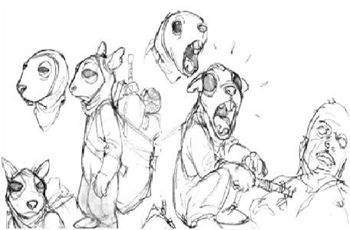5 Classic Video Games That Were Almost Hilariously Different

Somewhere there's an alternate universe in which the Mortal Kombat game starred Jean-Claude Van Damme. Gaming is actually full of "what if?" scenarios like this. For example ...
Half-Life's Protagonist Was Originally A Dwarven Biker

Half-Life tells the story of bespectacled armored physicist Gordon Freeman and his battle against an insidious alien force. Far from looking like your traditional space marine, he looks more like Edward Snowden after not shaving for a couple of days. However, the character might not be so popular today if they had run with the initial character model (on the right):

"Meth: Not Even Once."
The early prototype by character designer Chuck Jones more closely resembled a perpetually surprised lumberjack making the minimum possible effort at a Halo fan convention. Before they settled on a name, the designers nicknamed him "Ivan the Space Biker."

"... AND MY CROWBAR!"
This wasn't just some drunken idea scrawled on a bar napkin, either, but the actual character model that was used for an embarrassingly long time, lasting well into the testing phase.
Finally realizing that a character who looks like he sells crystal meth behind Showbiz Pizza probably wasn't the best hook to hang a franchise on, the designers eventually decided to dial back the facial hair and gave Gordon a tasteful dye job and a pair of glasses. The model can still be found deep within the game's code, though it can't be opened without a little computer wizardry and an insatiable desire to see a more terrible version of your favorite game.
BioShock's "Little Sisters" Were Almost Giant Slugs (Or Worse)

BioShock is set in a dystopian future run by people who not only managed to make it all the way through Atlas Shrugged, but decided to base a whole society on it. One of the more terrifying aspects of the game are the "Little Sisters" -- brainwashed, glowing-eyed little girls tasked with running around the crumbling city and extracting genetic material from the many corpses littering the ground. When the player comes across a Little Sister, they can choose to kill her and take all her genetic material for themselves, or save her for a much less bountiful amount of material. This choice determines which ending you get when you beat the game.

None of the endings involve getting these poor kids some Visine.
In the planning stage, the designers weren't quite sure what these "harvesters" were going to look like, and the initial idea was to make them giant slugs. But the senior concept artist pointed out that it was hard to give the player a moral quandary about whether to spare a creature that most of us would beat to death with a barstool should we ever encounter it in real life.

It's like if H.R. Giger designed fleshlights.
Wisely realizing they needed the harvester to be something we could actually feel sorry for, they decided to try and come up with the most pathetic thing imaginable, a creative process that naturally resulted in a dog in a wheelchair.

Testers didn't want to kill SUCH A GOOD BOY!
An alternative design along these lines was a frog with a funnel stuck to its butt, a somewhat less obviously tragic creature, but one no less deserving of our pity:

"K-kill m-me. End my eternal suffering."
And because to achieve greatness you have to be willing to try literally anything, humanoid chipmunks were also proposed:

Don't, don't, don't-don't-don't-don't! Don't, don't, don't-don't-don't-don't!
Eventually, the design team landed on the idea of brainwashed little girls straight out of a Tim Burton movie about a magical orphanage. It's unclear whether they recognized this for the truly good idea it was, or merely chose the Little Sisters because they were the first idea that wasn't comically ridiculous. Either way, the Little Sisters clicked, and became one of the most iconic images from the BioShock series.
Perfect Dark was Rare's attempt at topping themselves after their 1997 smash hit GoldenEye 007. The plot had something to do with fighting aliens, but like many first-person shooter games, the single-player story was mostly an afterthought to the multiplayer mode.
Hoping to improve upon GoldenEye's legendary multiplayer experience, Rare announced that Perfect Dark would include the added feature of enabling the player to virtually murder their friends and family, a dragon we still chase to this day. The game was planned to come with a "face-mapping" feature that would enable you to take a photo of someone using the Game Boy's largely forgotten camera accessory, upload it to the N64, and replace the faces of your in-game opponents with those of the people in your life.

If you've ever wanted to know what it's like to obliterate Ron Jeremy.
Reportedly, the feature was canceled due to "insurmountable technical problems" -- even though it seemed to be working pretty well in E3 demonstrations. There is a rumor, unconfirmed though fairly convincing, that Rare scrapped the concept after deciding that it might be a feature that appealed exclusively to burgeoning murderers who are only kept in check by their inability to locate the keys to their parents' gun cabinet.
This decision was probably further influenced by the Columbine High School massacre, which occurred midway through the game's development. Selling a game to teenagers with a feature that allows them to shoot their friends seems like way less fun when a high school spree killing is dominating the news cycle. In any case, the cancellation is probably for the best, if only because it would inevitably have led to a multiplayer experience in which the player fights a bunch of enemies whose faces have been replaced by dicks and swastikas.

Samus Aran, the main character of the Metroid series, is generally considered one of the first female playable characters in a video game, a Rubicon it took until 1986 for game developers to cross. Even then, the fact that she was female was originally nothing but an Easter Egg the player was rewarded with if they finished the game within a certain amount of time -- in a 10-second cut-scene, Samus strips off layers of bulky space marine armor to reveal a girl in a bra and panties! It may seem ridiculous, but who among us can say that they don't immediately remove their pants after coming home from a hard day at work?

We usually have to take our shoes off before that, but whatever.
When Super Metroid came out for the SNES, it was already well established among fans that Samus was a woman, so they couldn't really pull the same twist twice. What they did instead was have Samus explode out of her clothing during her death animation, revealing her fully nude body for just one frame.

This, minus the bikini.
In the 1990s, back when the only porn anyone could get their hands on was either secondhand magazines found in the woods or briefly visible snippets of scrambled Cinemax, this was the most erotic thing any videogame-playing youngster had ever seen.
According to the developers, they decided to replace Samus' nude death animation with one in which she was wearing a bathing suit, because "this sort of thing was terrible in America." Also, the developers probably (hopefully?) shuddered at the thought that countless sweaty-palmed teenagers would absolutely be masturbating to a single frame of a naked woman in the throes of violent death. Oh, and they said they had to replace the original audio clip of her dying because they had accidentally made it "too sexual." It is impossible to know if they're joking.
The Original Street Fighter Forced You To Pound Buttons With Your Fists

Street Fighter II is so legendary in the history of fighting games that it's easy to forget that, as the very name of it implies, there must have been a Street Fighter I at some point. And there was! The 1987 original Street Fighter arcade game was very similar to the hugely popular sequel, except that you could only play as Ryu (unless you were playing against another person, in which case player two was Ken), and the final boss was Sagat, an eight-foot Muay Thai champion with intense body issues about his nipples.

"I may have beaten someone to death in the street but I still have my dignity!"
But the first Street Fighter arcade machines, designed by Atari, featured just two gigantic buttons ("punch" and "kick"). The buttons were pressure-sensitive, meaning that the strength of your attack depended on how hard you could pound your fist on that button. Basically, you had to execute a precision test of strength every time you attempted to do a move. This is dangerously close to exercise, the antithesis of playing a videogame.

The concept of punching your controller would come back years later when XBox Live was invented.
It may seem quaint and borderline adorable now, but back then, Capcom assumed that gamers were a delicate and casual bunch, not the obsessive controller-destroying savants they actually are. As a result of players repeatedly hammering their fists on the buttons as hard as they possibly could in desperate attempts to topple the gigantically naked Sagat, arcades found themselves facing a high turnover of broken cabinets (and presumably, fractured wrists).
In response, Capcom redesigned the game with the six-button system that has become standard today, one that favors precision rather than physical strength. Ironically, the injuries sustained while trying to hammer out combinations on the original Street Fighter arcade cabinet is closer to being in an actual fight than most gamers of the 1980s ever got.
When not obsessing over pointless pop culture trivia, Henrik Magnusson also enjoys harassing the Internet with his comics. You can also go bug him on Twitter or Tumblr .
Also check out 6 Popular Games That Were Meant to Be Totally Different and The 6 Worst Ideas Nearly Included In Great Video Games.
Subscribe to our YouTube channel, and check out 7 Video Game Puzzles That Made No !@$&ing Sense, and other videos you won't see on the site!
Follow us on Facebook, and let's be best friends forever.

